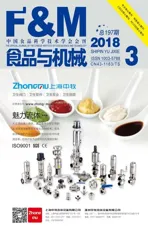茶黄素抗氧化化学机制研究
2018-05-31虹XIEHong罗志聪李熙灿
谢 虹XIE Hong 罗志聪 - 李熙灿 -
(广州中医药大学中药学院,广东 广州 510006)
红茶是一种全发酵型茶类,因其香气甜纯、滋味浓厚而广泛受到世界消费者的喜爱。茶黄素(图1)是红茶在发酵过程中,由简单儿茶素类聚合而成的黄烷醇类化合物[1],是衡量红茶品质的重要因素。现代药理学研究表明,茶黄素有显著的抗肿瘤[2]、抗炎[3]、抗氧化作用[4-5],是红茶发挥保健作用的重要物质基础。陈虎等[6]认为茶黄素能调节体内生物酶系的活性、防止低密度脂蛋白的氧化,修复生物系统的氧化损伤。最新的研究[7-8]还表明,茶黄素能通过hedgehog或Shh等信号通路限制肝的瘤变。但这些研究侧重阐明其抗氧化的生物机制,没有涉及化学机制。
本研究采用化学模式,研究茶黄素清除各种自由基的清除活性。在此基础上,进一步讨论其机制,以阐释茶黄素体内抗氧化的化学本质。

图1 茶黄素的结构式Figure 1 Structure of theaflavin
1 材料与方法
1.1 材料与仪器
1.1.1 材料与试剂
茶黄素(CAS:4670-5-7):HPLC≥98%,四川省维克奇生物科技有限公司;
新铜试剂、DPPH(1,1-二苯基-2-三硝基苯肼)自由基、Trolox:HPLC≥98%,西格玛奥德里奇(上海)贸易有限公司;
(NH4)2ABTS [2,2’-联氮-二(3-乙基-苯并噻唑-6-磺酸)二铵盐]:美国Amresco公司;
K2S2O8、CuSO4、CH3COONH4、95%乙醇:AR级,广州化学试剂厂。
1.1.2 仪器设备
紫外-可见分光光度计:UV2100型,上海尤尼柯仪器有限公司;
电子天平:BS110S型,北京赛多利斯天平有限公司。
1.2 试验方法
1.2.1 DPPH·清除能力的测定 依据文献[9]并做适量修改。称取1 mg DPPH,加入95%乙醇20 mL,超声使之完全溶解。取溶解后的DPPH·溶液1 mL与95%乙醇500 μL混合,利用紫外分光光度计在519 nm下测吸光度(A0)值。取该DPPH·溶液1 mL分别与20,40,60,80,100 μL的茶黄素溶液(0.1 mg/mL)混合,再向其中分别加入480,460,440,420,400 μL的95%乙醇使之总体积为1.5 mL,静置30 min 后,在519 nm下测吸光度值。平行测定3次。以Trolox(0.1 mg/mL)为阳性对照。样品清除DPPH·的能力按式(1)计算:
(1)
式中:
R——自由基清除率,%;
A0——未加样品液时所测吸光度值;
A——加入样品液时所测吸光度值。
1.2.2 ABTS+·清除能力的测定 依据文献[10]并做适量修改。取7.4 mmol/L (NH4)2ABTS溶液和2.6 mmol/L K2S2O8溶液各1 mL混合,在室温避光下放置12 h,使之反应完全。用95%乙醇稀释此ABTS+·工作液,利用紫外分光光度计在734 nm下测A0值,调整A0至(0.7±0.02)。取该ABTS+·工作液800 μL,加茶黄素(0.025 mg/mL)xμL(x=15,30,45,60,75),再加95%乙醇(200-x) μL,振摇10 s 以充分混合,然后在734 nm下测定吸光度值,平行检测3次。以Trolox (0.025 mg/mL)标准品为阳性对照。样品清除ABTS+·的能力按式(1)计算。
1.2.3 Cu2+还原能力的测定 依据文献[11]并做适量修改。取0.01 mol/L CuSO4溶液和7.5 mmol/L新铜试剂各125 μL混匀,依次加入茶黄素(0.1 mg/mL)xμL(x=15,30,45,60,75,90)、CH3COONH4缓冲液(700-x) μL,混合,静置30 min,于450 nm处测吸光度值,平行检测3次。以Trolox (0.1 mg/mL)标准品为阳性对照。样品Cu2+还原能力按式(2)计算:
(2)
式中:
S——Cu2+的相对还原率,%;
A0——未加样品液时所测吸光度值;
Amax——一次测量内最大的吸光度值;
A——加入样品液时所测吸光度值。
1.2.4 数据分析 每个样品重复3次试验,试验结果以平均值±标准差表示,采用SPSS 13.0对数据进行t检验。P<0.05 表示具有统计学意义。
2 结果与讨论
2.1 DPPH自由基清除活性及机制
DPPH自由基是一种以N为中心的稳定自由基,由于其分子中存在多个吸电子的—NO2和苯环的大π键,所以氮自由基能稳定存在[12]。DPPH自由基的乙醇溶液为深紫色,其在517 nm处有强吸收。若与样品混合,反应液的颜色变淡,同时在517 nm下吸光度值减少,据此可以判断样品清除DPPH自由基的能力[13]。从图2中可以看出,在0~6 μg/mL 的浓度范围内,茶黄素清除DPPH·的能力逐渐增加,并且表现出良好的量效关系。其IC50=(7.7±0.1) μmol/L,小于Trolox的(见表1),说明茶黄素清除DPPH·的能力强于Trolox。此前的文献[14]认为,氢原子转移(hydrogen atom transfer,HAT)是DPPH·清除涉及到的一种重要机制,活泼的DPPH·接受了一个氢原子后形成了稳定的DPPH—H分子。因此,DPPH·清除模型可以用来衡量抗氧化剂的HAT能力[15]。
依据文献[16],茶黄素分子与DPPH·发生的反应,可表示为图3。在反应中,茶黄素上的邻二酚羟基(O—H键)发生均裂,失去H·后形成茶黄素自由基(I),H·与DPPH· 结合生成稳定的DPPH—H分子。茶黄素自由基(I),进一步转化为更稳定的邻苯醌式产物(II)。不难看出,正是邻苯醌式产物的稳定性,导致了茶黄素分子的强抗氧化活性。因此,茶黄素发挥其体外抗氧化作用可能与其具有的HAT能力有关。值得一提的是,茶黄素的邻苯醌式产物多存在于环状化合物,链状化合物由于不具有环状结构,无法转变为醌式结构,所以大多不表现出抗氧化活性(如十六酸)[17]。

表1 茶黄素和Trolox在各种抗氧化分析法中的IC50值†Table 1 The IC50 values of theaflavin and Trolox in several antioxidant assays
†IC50值是指当自由基的清除率为50%时样品的浓度;同行不同字母表示差异显著(P<0.05)。

图2 茶黄素和Trolox的DPPH自由基清除率曲线Figure 2 The dose response curves of theaflavin and Trolox in DPPH·-scavenging assay

图3 茶黄素与DPPH·可能发生的反应式Figure 3 The proposed reaction of theaflavin with DPPH·
2.2 ABTS自由基清除活性及机制
ABTS法是一种经典的检测物质抗氧化能力的方法[18],适用于天然的或合成的抗氧化剂[19]。(NH4)2ABTS与K2S2O8反应可以生成稳定的ABTS+·自由基,此自由基呈深绿色,在734 nm处有最大吸收。如果ABTS+·被样品清除,其734 nm的吸光度值会降低,颜色变浅。据此,可以来判断样品清除ABTS+·的能力[20]。从图4中可以看出,在0~2 μg/mL的浓度范围内,茶黄素清除ABTS+·的能力与其浓度形成良好的量效关系。其IC50值为(2.3±0.1) μmol/L,小于Trolox的(见表1),说明茶黄素清除ABTS+·的能力强于Trolox。通常认为ABTS+·被清除的机制是电子转移(ET)的过程(ABTS+· +e→ ABTS)[21]。据此推测,茶黄素有较强的ABTS+·清除能力,其清除过程至少包括ET机制。
2.3 Cu2+还原能力及机制
抗氧化剂对金属离子的还原能力,也可用于衡量其活性强弱[22]。从图5中可以看出,在0~90 μg/mL的质量浓度范围内,茶黄素对铜离子的相对还原率与浓度呈现出良好的线性关系。其IC50=(9.2±0.2) μmol/L,小于Trolox的(见表1),表明茶黄素还原Cu2+的能力强于Trolox。文献[20]表明,Cu2+被还原成Cu+是电子转移的过程。这进一步印证了茶黄素具有ET能力的推测。

图4 茶黄素和Trolox的ABTS+·清除率曲线
Figure 4 The dose response curves of theaflavin and Trolox in ABTS+·-scavenging assay

图5 茶黄素和Trolox 的相对Cu2+还原能力浓度曲线
Figure 5 The dose response curves of theaflavin and Trolox in Cu2+-reducing assay
3 结论
作为一种存在于红茶中的天然抗氧化剂,茶黄素在DPPH自由基清除、ABTS清除、Cu2+还原力3个方面,其活性均明显强于Trolox。它的抗氧化作用可能涉及氢原子转移(HAT)和电子转移(ET)。并且通过HAT机制,茶黄素可转化为稳定的邻苯醌式产物。此研究阐明了茶黄素抗氧化的化学机制,有助于理解抗氧化活性与结构的关系,为茶黄素类衍生物的开发利用提供理论基础。但该试验对于茶黄素所涉及的化学机制研究尚不全面,仍有待进一步分析完善。
[1] KUSANO R, MATSUO Y, SAITO Y, et al. Oxidation mechanism of black tea pigment theaflavin by peroxidase[J]. Tetrahedron Letters, 2015, 56: 5 099-5 102.
[2] GAO Ying, RANKIN G O, TU You-ying, et al. Inhibitory effects of the four main theaflavin derivatives found in black tea on ovarian cancer cells[J]. Anticancer Research, 2016, 36(2): 643-651.
[3] CAI Fei, LI Cai-rong, WU Ji-liang, et al. Theaflavin ameliorates cerebral ischemia-reperfusion injury in rats through its anti-inflammatory effect and modulation of STAT-1[J]. Mediators of Inflammation, 2006, 5: 30 490.
[4] MANGERICH A, KNUTSON C G, PARRY N M, et al. Infection-induced colitis in mice causes dynamic and tissue-specific changes in stress response and DNA damage leading to colon cancer[J]. Proceedings of the National Academy of Sciences of the United states of America, 2012, 109(27): E1 820-E1 829.
[5] 沈丽萍. 茶黄素研究进展[J]. 中国农学通报, 2010, 26(1): 134-139.
[6] 陈虎, 胡英, 周睿, 等. 茶黄素的抗氧化机理的研究进展[J]. 茶叶科学, 2005, 25(4): 237-241.
[7] SUR S, PAL D, MANDAL S, et al. Tea polyphenols epigallocatechin gallete and theaflavin restrict mouse liver carcinogenesis through modulation of self-renewal Wnt and hedgehog pathways[J]. Journal of Nutritional Biochemistry, 2016, 27: 32-42.
[8] LI Xi-can, WEI Gang, WANG Xiao-zhen, et al. Targeting of the shh pathway by atractylenolides promotes chondrogenic differentiation of mesenchymal stem Cells[J]. Biological & Pharmaceutical Bulletin, 2012, 35: 1 328-1 335.
[9] WANG Ting-ting, ZENG Gong-chang, LI Xi-can, et al. In vitro studies on the antioxidant and protective effect of 2-substituted-8-hydroxyquinoline derivatives against H2O2-Induced oxidative stress in BMSCs[J]. Chemical Biological Drug Design, 2010, 75(2): 214-222.
[10] LI Xi-can, CHEN Dong-feng, MAI Ying, et al. Concordance between antioxidant activities in vitro and chemical components of Radix Astragali (Huangqi)[J]. Natural Product Research, 2012, 26: 1 050-1 053.
[11] LI Xi-can, LIU Jing-jing, LIN Jian, et al. Protective effects of dihydromyricetin against ·OH-induced mesenchymal stem cells damage and mechanistic chemistry[J]. Molecules, 2016, 21: 604.
[12] LI Xi-can, JIANG Qian, WANG Ting-ting, et al. Comparison of the antioxidant effects of quercitrin and isoquercitrin: Understand-ing the role of the 6″-OH group[J]. Molecules, 2016, 21: 1 246.
[13] LI Xi-can, HAN Lu, LI Yung-rong, et al. Protective effect of sinapine against hydroxyl radical-induced damage to mesenchymal stem cells and possible mechanisms[J]. Chemical & Pharmaceutical Bulletin, 2016, 64: 319-325.
[14] LI Xi-can, HAN Wei-juan, MAI Wen-qiong, et al. Antioxidant Activity and Mechanism of Tetrahydroamentoflavone in vitro[J]. Natural Product Communications, 2013, 8: 787-789.
[15] WANG Guang-rong, LI Xi-can, ZENG He-ping. Synthesis, antioxidation activity of (E)-9-p-Tolyl-3-[2-(8-hydroxy-quinol-2-yl)vinyl]-carbazole and (E)-9-(p-Anisyl)-3-[2-(8-hydroxy-quinol-2-yl)vinyl]-carbazole and their induction proliferation of mesenchymal stem cells[J]. Acta Chimica Sinica, 2009, 67(9): 974-982.
[16] CHEN Dong-feng, LI Xi-can, XU Zhi-wei, et al. Hexadecanoic acid from buzhong yiqi decoction induces proliferation of bone marrow mesenchymal stem cells[J]. Journal of Medicinal Food, 2010, 13: 967-970.
[17] LI Xi-can, HU Qiu-ping, JIANG Shu-xia, et al.FlosChrysanthemiIndiciprotects against hydroxyl-induced damages to DNA and MSCs via antioxidant mechanism: A chemistry study[J]. Journal of Saudi Chemical Society, 2015, 19: 454-460.
[18] TAN Dun-xian, HARDELAND R, MANCHESTER L, et al. Mechanistic and comparative studies of melatonin and classic antioxidants in terms of their interactions with the ABTS cation radical[J]. Journal of Pineal Research, 2003, 34: 249-259.
[19] LIN Jian, LI Xi-can, CHEN Li, et al. Protective effect against hydroxyl radical-induced DNA damage and antioxidant mechanism of [6]-gingerol: A chemical study[J]. Bulletin of the Korean Chemical Society, 2014, 6: 1 633-1 638.
[20] LI Xi-can, MAI Wen-qiong, CHEN Dong-feng, et al. Chemical study on protective effect against hydroxyl-induced DNA damage and antioxidant mechanism of myricitrin[J]. Journal of the Chinese Chemical Society, 2014, 61: 383-390.
[21] LIU Jing-jing, LI Xi-can, LIN Jian, et al. Sarcandra glabra (Caoshanhu) protects mesenchymal stem cells from oxidative stress: A bioevaluation and mechanistic chemistry[J]. BMC Complementary and Alternative Medicine, 2016, 16: 423.
[22] VALENT I, TOPOLSKD, VALACHOVK, et al. Kine-tics of ABTS derived radical cation scavenging by bucillamine, cysteine, and glutathione: Catalytic effect of Cu2+ions[J]. Biophysical Chemistry, 2016, 212: 9-16.
